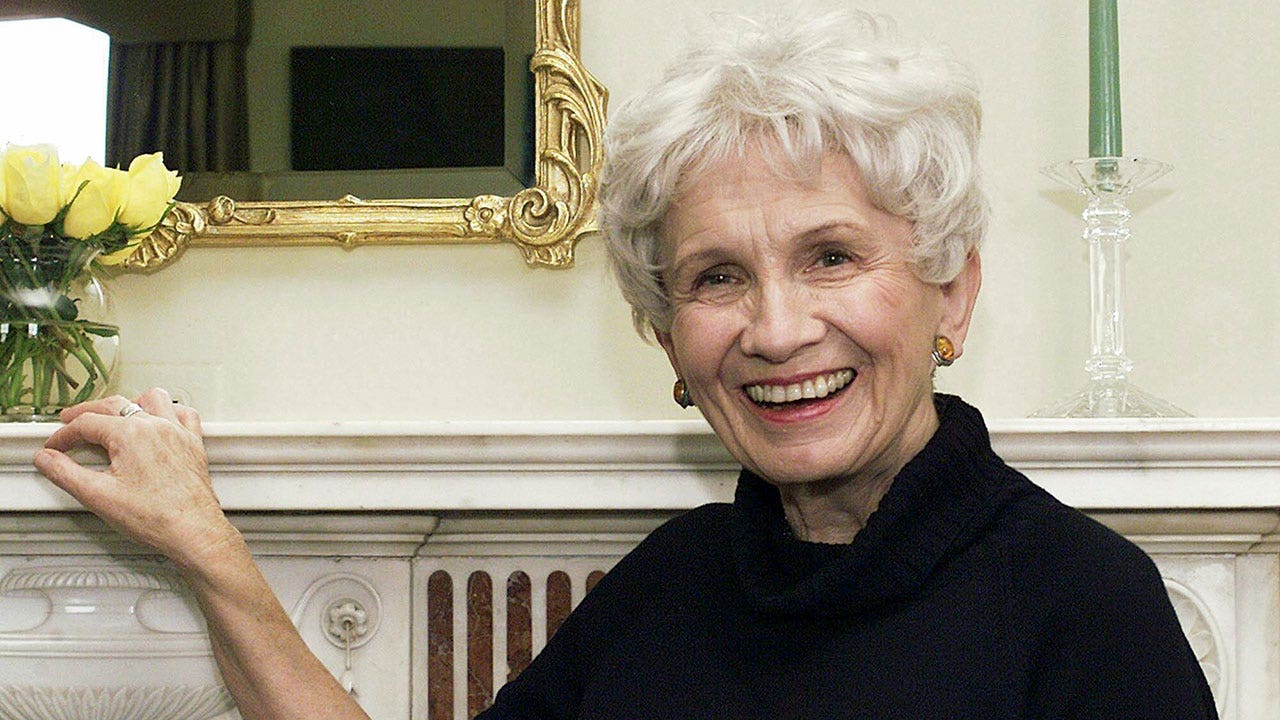INTERNACIONAL
Nobel literature winner Alice Munro, revered as short story master, dies at 92

- Alice Munro, the Canadian literary icon and Nobel laureate, died at the age of 92 at her home in Port Hope, Ontario.
- Her works, including «Dear Life,» «Too Much Happiness,» «The View from Castle Rock,» and «The Love of a Good Woman,» gained widespread popularity.
- Munro won the Nobel Prize in Literature in 2013.
Nobel laureate Alice Munro, the Canadian literary giant who became one of the world’s most esteemed contemporary authors and one of history’s most honored short story writers, has died at age 92.
A spokesperson for publisher Penguin Random House Canada said Munro, winner of the Nobel literary prize in 2013, died Monday at home in Port Hope, Ontario. Munro had been in frail health for years and often spoke of retirement, a decision that proved final after the author’s 2012 collection, «Dear Life.»
Often ranked with Anton Chekhov, John Cheever and a handful of other short story writers, Munro achieved stature rare for an art form traditionally placed beneath the novel. She was the first lifelong Canadian to win the Nobel and the first recipient cited exclusively for short fiction. Echoing the judgment of so many before, the Swedish academy pronounced her a «master of the contemporary short story» who could «accommodate the entire epic complexity of the novel in just a few short pages.»
AMERICAN AUTHOR PAUL AUSTER, KNOWN FOR ‘THE NEW YORK TRILOGY,’ DIES AT 77
Munro, little known beyond Canada until her late 30s, also became one of the few short story writers to enjoy ongoing commercial success. Sales in North America alone exceeded 1 million copies and the Nobel announcement raised «Dear Life» to the high end of The New York Times’ bestseller list for paperback fiction. Other popular books included «Too Much Happiness,» «The View from Castle Rock» and «The Love of a Good Woman.»
Canadian author Alice Munro poses for a photograph at the Canadian Consulate’s residence in New York on Oct. 28, 2002. Munro, the Canadian literary giant who became one of the world’s most esteemed contemporary authors and one of history’s most honored short story writers, has died at age 92. (AP Photo/Paul Hawthorne, File)
Over a half century of writing, Munro perfected one of the greatest tricks of any art form: illuminating the universal through the particular, creating stories set around Canada that appealed to readers far away. She produced no single definitive work, but dozens of classics that were showcases of wisdom, technique and talent — her inspired plot twists and artful shifts of time and perspective; her subtle, sometimes cutting humor; her summation of lives in broad dimension and fine detail; her insights into people across age or background, her genius for sketching a character, like the adulterous woman introduced as «short, cushiony, dark-eyed, effusive. A stranger to irony.»
Her best known fiction included «The Beggar’s Maid,» a courtship between an insecure young woman and an officious rich boy who becomes her husband; «Corrie,» in which a wealthy young woman has an affair with an architect «equipped with a wife and young family»; and «The Moons of Jupiter,» about a middle-aged writer who visits her ailing father in a Toronto hospital and shares memories of different parts of their lives.
«I think any life can be interesting,» Munro said during a 2013 post-prize interview for the Nobel Foundation. «I think any surroundings can be interesting.»
CORMAC MCCARTHY, PULITZER PRIZE-WINNING AUTHOR OF ‘THE ROAD,’ DEAD AT 89
Disliking Munro, as a writer or as a person, seemed almost heretical. The wide and welcoming smile captured in her author photographs was complemented by a down-to-earth manner and eyes of acute alertness, fitting for a woman who seemed to pull stories out of the air the way songwriters discovered melodies. She was admired without apparent envy, placed by the likes of Jonathan Franzen, John Updike and Cynthia Ozick at the very top of the pantheon. Munro’s daughter, Sheila Munro, wrote a memoir in which she confided that «so unassailable is the truth of her fiction that sometimes I even feel as though I’m living inside an Alice Munro story.» Fellow Canadian author Margaret Atwood called her a pioneer for women, and for Canadians.
«Back in the 1950s and 60s, when Munro began, there was a feeling that not only female writers but Canadians were thought to be both trespassing and transgressing,» Atwood wrote in a 2013 tribute published in the Guardian after Munro won the Nobel. «The road to the Nobel wasn’t an easy one for Munro: the odds that a literary star would emerge from her time and place would once have been zero.»
Although not overtly political, Munro witnessed and participated in the cultural revolution of the 1960s and ’70s and permitted her characters to do the same. She was a farmer’s daughter who married young, then left her husband in the 1970s and took to «wearing miniskirts and prancing around,» as she recalled during a 2003 interview with The Associated Press. Many of her stories contrasted the generation of Munro’s parents with the more open-ended lives of their children, departing from the years when housewives daydreamed «between the walls that the husband was paying for.»
Moviegoers would become familiar with «The Bear Came Over the Mountain,» the improbably seamless tale of a married woman with memory loss who has an affair with a fellow nursing home patient, a story further complicated by her husband’s many past infidelities. «The Bear» was adapted by director Sarah Polley into the feature film «Away from Her,» which brought an Academy Award nomination for Julie Christie. In 2014, Kristen Wiig starred in «Hateship, Loveship,» an adaptation of the story «Hateship, Friendship, Courtship, Loveship, Marriage,» in which a housekeeper leaves her job and travels to a distant rural town to meet up with a man she believes is in love with her — unaware the romantic letters she has received were concocted by his daughter and a friend.
Even before the Nobel, Munro received honors from around the English-language world, including Britain’s Man Booker International Prize and the National Book Critics Circle award in the U.S., where the American Academy of Arts and Letters voted her in as an honorary member. In Canada, she was a three-time winner of the Governor General’s Award and a two-time winner of the Giller Prize.
Munro was a short story writer by choice, and, apparently, by design. Judith Jones, an editor at Alfred A. Knopf who worked with Updike and Anne Tyler, did not want to publish «Lives of Girls & Women,» her only novel, writing in an internal memo that «there’s no question the lady can write but it’s also clear she is primarily a short story writer.»
Munro would acknowledge that she didn’t think like a novelist.
«I have all these disconnected realities in my own life, and I see them in other people’s lives,» she told the AP. «That was one of the problems, why I couldn’t write novels. I never saw things hanging together too well.»
Alice Ann Laidlaw was born in Wingham, Ontario, in 1931, and spent much of her childhood there, a time and place she often used in her fiction, including the four autobiographical pieces that concluded «Dear Life.» Her father was a fox farmer, her mother a teacher and the family’s fortunes shifted between middle class and working poor, giving the future author a special sensitivity to money and class. Young Alice was often absorbed in literature, starting with the first time she was read Hans Christian Andersen’s «The Little Mermaid.» She was a compulsive inventor of stories and the «sort of child who reads walking upstairs and props a book in front of her when she does the dishes.»
A top student in high school, she received a scholarship to study at the University of Western Ontario, majoring in journalism as a «cover-up» for her pursuit of literature. She was still an undergraduate when she sold a story about a lonely teacher, «The Dimensions of a Shadow,» to CBC Radio. She was also publishing work in her school’s literary journal.
One fellow student read «Dimensions» and wrote to the then-Laidlaw, telling her the story reminded him of Chekhov. The student, Gerald Fremlin, would become her second husband. Another fellow student, James Munro, was her first husband. They married in 1951, when she was only 20, and had four children, one of whom died soon after birth.
Settling with her family in Vancouver, Alice Munro wrote between trips to school, housework and helping her husband at the bookstore that they co-owned and would turn up in some of her stories. She wrote one book in the laundry room of her house, her typewriter placed near the washer and dryer. Flannery O’Connor, Carson McCullers and other writers from the American South inspired her, through their sense of place and their understanding of the strange and absurd.
Isolated from the literary center of Toronto, she did manage to get published in several literary magazines and to attract the attention of an editor at Ryerson Press (later bought out by McGraw Hill). Her debut collection, «Dance of the Happy Shades,» was released in 1968 with a first printing of just under 2,700 copies. A year later it won the Governor’s General Award and made Munro a national celebrity — and curiosity. «Literary Fame Catches City Mother Unprepared,» read one newspaper headline.
«When the book first came they sent me a half dozen copies. I put them in the closet. I didn’t look at them. I didn’t tell my husband they had come, because I couldn’t bear it. I was afraid it was terrible,» Munro told the AP. «And one night, he was away, and I forced myself to sit down and read it all the way through, and I didn’t think it was too bad. And I felt I could acknowledge it and it would be OK.»
By the early ’70s, she had left her husband, later observing that she was not «prepared to be a submissive wife.» Her changing life was best illustrated by her response to the annual Canadian census. For years, she had written down her occupation as «housewife.» In 1971, she switched to «writer.»
Over the next 40 years, her reputation and readership only grew, with many of her stories first appearing in The New Yorker. Her prose style was straightforward, her tone matter of fact, but her plots revealed unending disruption and disappointments: broken marriages, violent deaths, madness and dreams unfulfilled, or never even attempted. «Canadian Gothic» was one way she described the community of her childhood, a world she returned to when, in middle age, she and her second husband relocated to nearby Clinton.
«Shame and embarrassment are driving forces for Munro’s characters,» Atwood wrote, «just as perfectionism in the writing has been a driving force for her: getting it down, getting it right, but also the impossibility of that.»
CLICK HERE TO GET THE FOX NEWS APP
She had the kind of curiosity that would have made her an ideal companion on a long train ride, imagining the lives of the other passengers. Munro wrote the story «Friend of My Youth,» in which a man has an affair with his fiancee’s sister and ends up living with both women, after an acquaintance told her about some neighbors who belonged to a religion that forbade card games. The author wanted to know more — about the religion, about the neighbors.
Even as a child, Munro had regarded the world as an adventure and mystery and herself as an observer, walking around Wingham and taking in the homes as if she were a tourist. In «The Peace of Utrecht,» an autobiographical story written in the late 1960s, a woman discovers an old high school notebook and remembers a dance she once attended with an intensity that would envelop her whole existence.
«And now an experience which seemed not at all memorable at the time,» Munro wrote, «had been transformed into something curiously meaningful for me, and complete; it took in more than the girls dancing and the single street, it spread over the whole town, its rudimentary pattern of streets and its bare trees and muddy yards just free of the snow, over the dirt roads where the lights of cars appeared, jolting toward the town, under an immense pale wash of sky.»
INTERNACIONAL
Was a beloved whale suspected of being a Russian ‘spy’ killed in Norway?

Havldimir quickly became a celebrity in Norway, swimming his way into their Nordic hearts.
But this beluga whale’s odd story started in 2019 when he was discovered in northern Norway near the island of Ingoya wearing a harness with «Equipment St Petersburg» written in English connected to a mount for a small camera.
Hvaldimir, as Norwegians dubbed him – mixing together the Norwegian word for whale and Russian President Vladimir Putin’s name – was intelligent, friendly and responded to hand signals, leading Norway’s spy agency to believe he had been held in captivity by Russia and used for research purposes.
Once Hvaldimir was freed from his harness, though, his friendly personality made him beloved in the country.
CRITICALLY ENDANGERED WHALE SEEN OFF CALIFORNIA COAST: ‘EVERY SIGHTING IS INCREDIBLE VALUABLE TO US’
Hvaldimir was found in 2019 wearing a harness with a camera mount on it. (Jorgen Ree Wiig/Sea Surveillance Service/Handout/NTB Scanpix via Reuters/File Photo)
He was fed and monitored by the Norwegian government and dubbed a «free-swimming whale» by the Norwegian Orca Survey, venturing as far as Sweden but always returning home, according to The Telegraph.
Hvaldimir was found dead off southern Norway last weekend.
«It’s absolutely horrible,» marine biologist Sebastian Strand, who worked with Marine Mind, told Norwegian public broadcaster NRK. «He was apparently in good condition as of (Friday), so we just have to figure out what might have happened here.»
BREACHING WHALE CAPSIZES BOAT AFTER LANDING ON TOP OF IT OFF NEW HAMPSHIRE, SHOCKING VIDEO SHOWS

Hvaldimir, being fed here, became beloved in Norway. (orgen Ree Wiig, Norwegian Directorate of Fisheries via AP)
Hvaldimir may have died of natural causes, but conservation groups NOAH and One Whale have filed police reports claiming he was shot, according to the Telegraph.
The Oceanic Preservation Society said that a necropsy will be done on Hvaldimir to determine his cause of death in the next few weeks.
«We’ve been absolutely devastated over the news, and are deeply saddened that humanity failed this beloved whale,» the organization said on social media.

He was fed and monitored by the Norwegian government and dubbed a «free-swimming whale» by the Norwegian Orca Survey, venturing as far as Sweden but always returning home. (Jorgen Ree Wiig, Norwegian Directorate of Fisheries via AP)
Nonprofit Marine Mind said on Facebook that Hvaldimir «bridged the gap» between humans and wild animals in a way «few can.»
CLICK HERE TO GET THE FOX NEWS APP
«Hvaldimir was not just a beluga whale; he was a beacon of hope, a symbol of connection, and a reminder of the deep bond between humans and the natural world,» the organization said. «Over the past five years, he touched the lives of tens of thousands, bringing people together in awe of the wonders of nature. His presence taught us about the importance of ocean conservation, and in doing so, he also taught us more about ourselves.»
Reuters and the Associated Press contributed to this report.
-
POLITICA2 días ago
La represión a los jubilados, un espejo en el que duele reconocerse
-
POLITICA1 día ago
“Estúpido” y “exlibertario”: reapareció Cristina Kirchner y cruzó muy duro a Javier Milei
-
POLITICA1 día ago
Milei versus Cristina: el Presidente le responde a la exvicepresidenta en el Congreso del IAEF y habla sobre el dólar y el cepo
-
POLITICA2 días ago
Javier Milei planea exponer el Presupuesto en el recinto de Diputados y ya genera polémica con la oposición
-
CHIMENTOS2 días ago
La versión de Victoria Onetto sobre su «aventura» con Alberto Fernández
-
POLITICA2 días ago
Argentina – Chile, en vivo





























